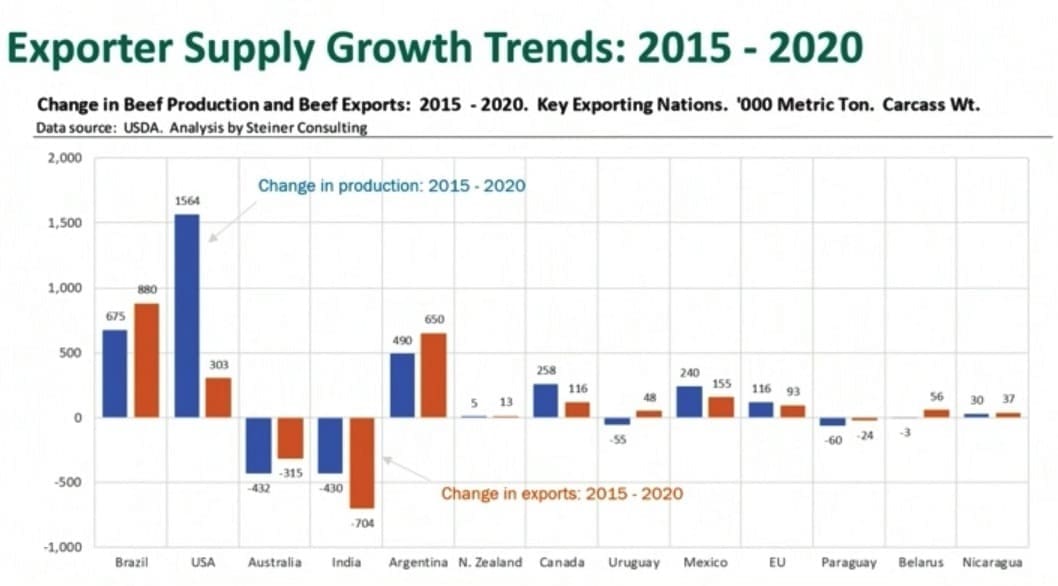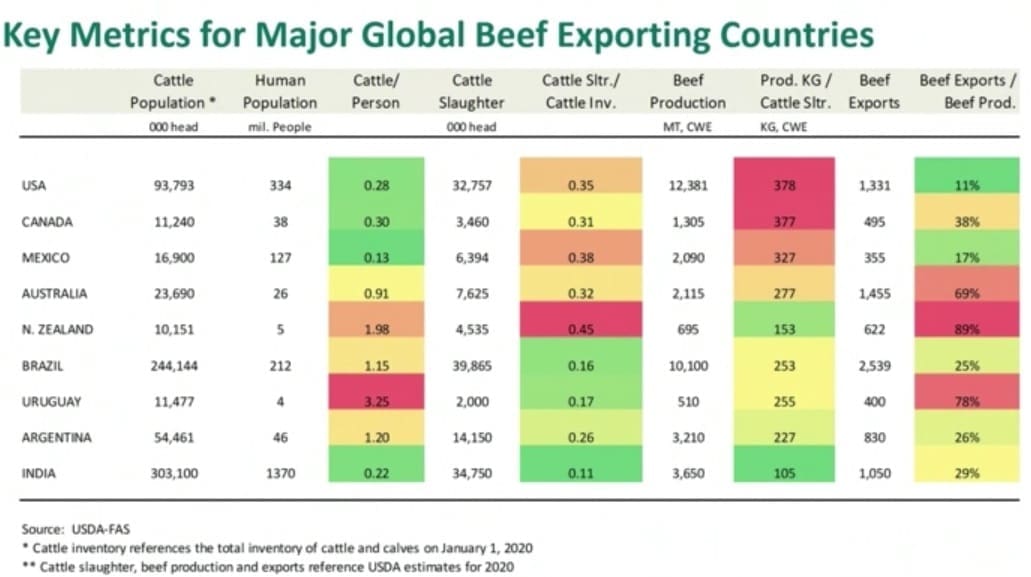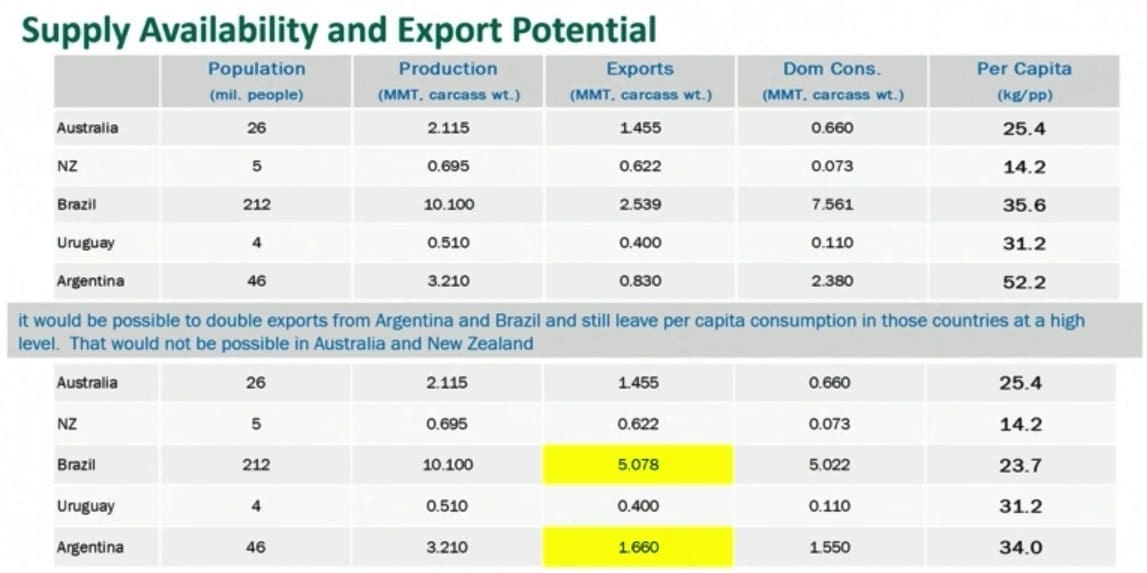BEEF exports out of South America could fall by anywhere from 7pc to 10pc this year, with a further 5pc next year, stakeholders participating in this week’s ABARES 2021 online conference were told.
Participating in a session on global beef export outlook, Australian analyst Simon Quilty from Global Agritrends said the South Americans had been ‘mining’ their beef herd for the past two years, because of the requirement that beef exports to China be limited to animals 30 months or less.
“Given the extent of South American exports into China over the past two years, that has seen a ‘liquidation’ of the region’s young female herd,” Mr Quilty said.
“The expectations are that in the first quarter this year, there will be a dramatic fall in volume of South American beef into China – and that will lift global beef prices, across the board,” he said.

Len Steiner
Also speaking on South American beef production and exports during this week’s ABARES virtual conference was US analyst Len Steiner, from Steiner Consulting.
Mr Steiner said most of the global beef supply growth currently being seen was coming out of the South American region.
He said exportable beef supplies out of the Oceania region (principally Australia and New Zealand) would be down in 2021, while North American and European growth in beef production would not keep up with population growth.
China had emerged over the past two years as the top beef market in the world – and South America had slowly transformed into its main supplier, he said.
While Australia’s beef herd was currently at a 30-year low point, herds in Brazil kept growing, Argentina had also ‘slipped-the-bit’, and Uruguay was on a rebound.
Mr Steiner’s graph below, showing export supply growth trends from 2015-20 (blue line indicates growth over the past five years in beef production, and the brown line for exports), shows that Brazil’s beef production had grown by 675,000t, while exports had grown even more, by 880,000t.
Argentina was showing a similar trend, with production up 490,000t and exports up 650,000t. Uruguay’s result was mixed, with production down 55,000t, while exports were up 48,000t.

The table below lists key metrics for the nine largest beef exporting nations.
One of the key figures was beef exports as a percentage of production numbers (right hand column), showing that Australia, New Zealand and Uruguay are currently high (red), while Brazil and Argentina are relatively low (green).
“This show that the Brazilians, Argentineans and American simply ‘love their beef’, and their large populations mean most of it is sold domestically,” Mr Steiner said.
China had grown to be the largest beef importer in the world over the past decade, and the majority of that beef last year (about 74pc, or 2.7 million tonnes carcase weight basis) came from South America.
“In 2020, the amount of beef shipped to China from both Brazil and Argentina grew dramatically, while it declined from Australia and Uruguay. For the year, total growth in imported beef to China was up about 48pc,” he said.
“Brazil’s total beef exports have been growing, and its total exports to China have grown even faster. For all three South American countries – Brazil, Argentina and Uruguay – their percentage of exports now heading to China have grown by between 46pc and 76pc.”

Movement in exchange rates was one reason why South America was increasingly dominating exports to China. Both Brazil’s and Argentina’s currencies versus the US$ had weakened substantially over the past couple of years, while Australia had strengthened, making our exports less competitive.
He said with the current shortfall in protein in China due to the African Swine Fever pandemic in the nation’s pig population, some calculations had suggested exports out of South America to China could still increase ‘a lot more’ (see table below).
“Pork clearly was China’s number one meat protein, by a long shot. But there is a middle class in China now that is clearly picking up an appetite for beef, and the South Americans are now supplying a large proportion of that,” Mr Steiner said.
“And Brazil, and especially Argentina, have cash-flow problems. If you want cash, you have to sell something that the world wants, and the world (and especially China) wants beef. It’s a matter of how much of their beef production in future is moved from domestic consumption into the export column.”
“In South America, it is also a political decision. Argentina, they previously tried to control beef exports, in order to lower domestic beef prices and inflation within the country. That didn’t work out so well for them, but it doesn’t mean they won’t try that again.”

Earlier, ABARES analyst Chris Mornement said both the US and Brazil had significantly increased their exports to Asian markets in the past 12 months – especially China.
“As the US cattle herd has peaked and is now entering a down cycle, we’re expecting to see US beef exports increasing, over the 2021 outlook period,” he said.
Brazil was also expected to continue to supply high volumes of beef to the global markets.
“A weak Real, and low domestic consumption suggests that Brazilian beef will be very competitive on global markets through the outlook period,” he said.
ABARES anticipates that cattle prices will fall from their recent highs over the medium term, driven by reduced demand in export markets and herd rebuilding.



HAVE YOUR SAY